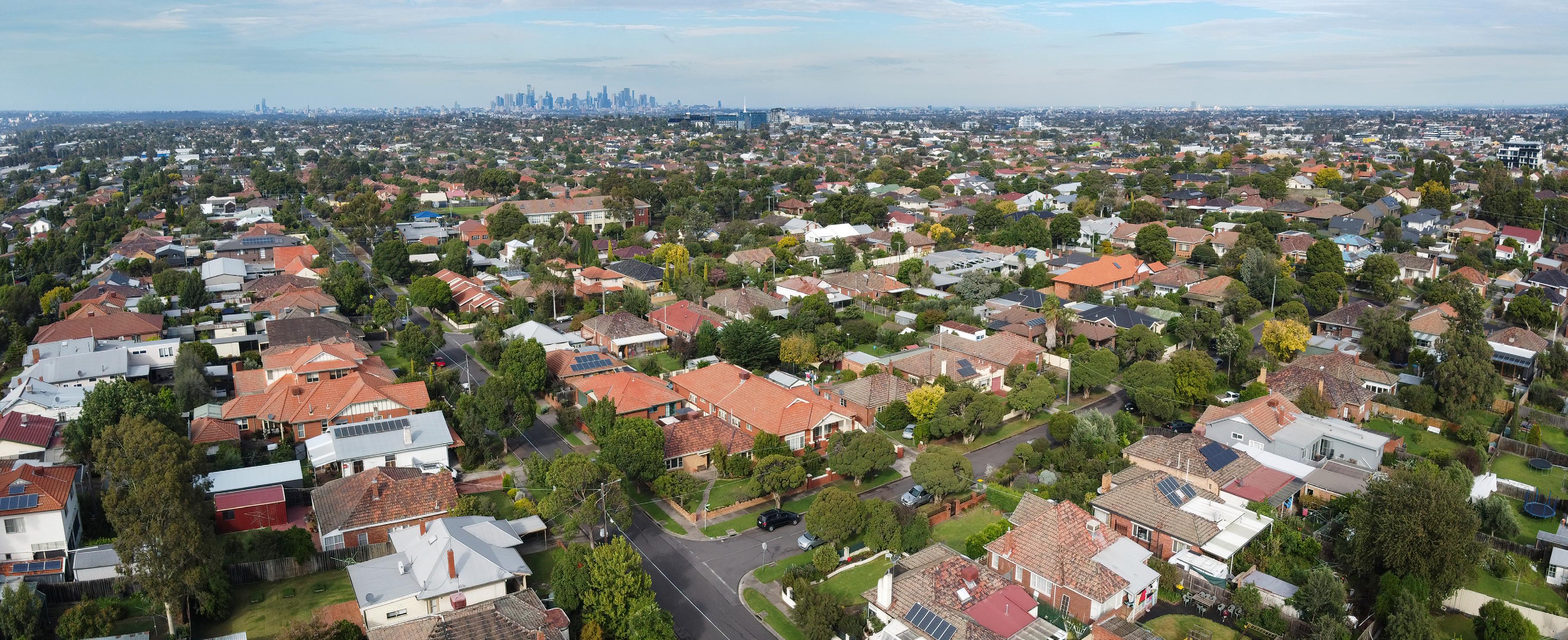
ECONOMIC AND RESIDENTIAL MARKET REPORT
APRIL 2025


ECONOMIC AND RESIDENTIAL MARKET REPORT
APRIL 2025

Michael Staedler
General Manager
Research, Data & Insights
m.staedler@rpmgrp.com.au
Economic activity remained subdued in Q4 2024, with GDP growing just 0.58% for the quarter, bringing annual growth to 1.27%.
That's well below the long-term average of 3.31% that Australians have grown used to. But beneath the headline figure, the mix of growth improved. Public demand continues to drive GDP, with a slight uptick in private demand - led by a lift in household spending.
Inflation held steady, rising just over 0.22% over Q4 - mirroring Q3 figures. This stability gave the Reserve Bank of Australia (RBA) enough confidence to reduce the cash rate in February, marking its first cut in five years. While this rate cut was largely expected, the path forward is less certain.
• GDP grew just 1.27% in 2024, well below the long term average.
• With inflation steady at 0.22% in Q4, the RBA cut rates in February. Uncertainty surrounds the direction and pace of the next move.
• Real wages are rising and consumer confidence is improving, but housing supply is constrained by fragile construction pipelines and elevated costs.
With global tariff tensions heating up, the RBA will be watching inflation closely. A tariff is simply an increase to the price so a spike could delay further cuts in the first half of 2025. On the flip side, if households and businesses pull back, along with cheaper products from overseas entering our marketets, deflationary pressure could emerge –prompting the RBA to make multiple rate cuts sooner to stimulate growth which is already below trend.
Real wages continue to improve. In Q4, wages rose 0.65% outpacing inflation (+0.22%). This lifted consumer confidence and nudged the household savings ratio up to 3.8%.
Population growth has slowed to a more sustainable pace, but the pressure on housing delivery has only intensified. Demand for new dwellings remain strong. Recent approvals offer a glimmer of optimism,
but the challenge now is converting them into commencements – and ultimately, completions. The pipeline remains fragile though; while construction costs have eased from their peaks, they remain high enough to make many projects (especially high-rise apartments) financially unfeasible.
This edition of our Economic and Residential Market Report offers a clear view of where the economy stands. We hope it offers greater clarity and confidence as you navigate your development goals.
For more information, please visit: www.rpmgrp.com.au
Our Research Consultancy Services create bespoke reports crafted to your specifications, translating rich data into in-depth analysis. For a bespoke report, email the team at: contactus@rpmgrp.com.au
This report presents and analyses the most recent economic and building datasets available as of
It also explores the current state of global uncertainty driven by newly imposed tariffs and includes a snapshot of key Federal Election promises from both the government and opposition.

As we settle into 2025, two major economic events have taken centre stage: Australia’s upcoming Federal Election on May 3, and a more unpredictable development – sweeping US tariffs under President Trump.
While the election will influence domestic policy, the tariffs are already shaking global markets, with potential flowon effects for Australia’s economy and property sector.
President Trump announced the largest shift in US trade policy in decades – a blanket 10% tariff on most imports, and significantly higher ‘reciprocal’ tariffs for countries running large trade surpluses with the US. In practical terms, this is a 2.4% of GDP tax hike on the US economy.
The impact was immediate. Forecasts for US GDP growth in 2025 have been slashed from 1.3% to just 0.6%. Inflation is now expected to reach 4%, unemployment is projected to rise, and both business confidence and household spending are under pressure – raising the real risk of a US recession.
China has borne the brunt of the tariffs, with some goods facing a 54% levy. It responded with its own 34% tariffs on US goods, plus export controls. Another round of increases across many of the goods took place, and by early April, China responded with 125% tax on selected items, following the USA’s 145% tax on Chinese goods.
China has called the tariffs “economically unsound” and lodged a complaint with the World Trade Organisation. For now, the USA has agreed to a 90-day pause for negotiations with willing partities – China is not one of these – but uncertainty remains high.
Escalation of US tariffs and global trade tensions
February
March
Trump signs executive order imposing tariffs on Mexico, Canada and China.
30-day pause for Mexico and Canada as they explore concessions.
10% tariffs on China take effect. China responds with counter-tariffs.
US announces 25% tariffs on steel and aluminium imports.
Trump proposes a system of "reciprocal" tariffs.
Tariffs on Mexico and Canada come into effect. Both seek to de-escalate.
China raises tariffs on US agriculture from 10% to 20%.
US grants 30-day exemption for US automakers on Mexican and Canadian imports.
China’s 15% tariff on US farm goods takes effect.
US steel and aluminium tariffs come into force.
EU retaliates with tariffs on US raw materials and agricultural goods.
Trump threatens 200% tariff on EU Wine after they imposes 50% on US whiskey.
Trump proposes 25% tariff on buyers of Venezuelan oil and gas.
25% auto import tariff announced, effective 3 April.
April
Trump releases list of "reciprocal" tariffs – 10% baseline; China at 54%.
China hits back with 34% tariff on all US goods and issues export controls on rare earth minerals.
US 10% minimum tariff on all countries takes effect.
"Reciprocal" tariffs take effect, then suspended for 90 days – China excluded.
Trump increases China’s rate to 104%, then 145%. China responds with 84%.
China escalates to 125% on US goods.US grants tariff exemption to various electronic devices made in China
Australia received the baseline 10% tariff, but since only 4-5% of our exports go to the US, the direct economic impact is minimal – an estimated 0.1-0.2% drag on GDP.
The bigger risk lies in indirect effects. China, and other key Asian trading partners, could scale back demand if their economies slow under the weight of the rising tariffs.
That would hit Australian industries like mining and pharmaceuticals harder, leaving Western Australia most exposed. The broader concern goes beyond falling export volumes – it's the potential hit to business and consumer confidence across the board.
To cushion the blow of global headwinds, the RBA is expected to cut rates in May, with markets pricing in up to four rate cuts through 2025 - suggesting the tariffs are here to stay at an elevated level. In theory, lower interest rates will support household spending and housing activity, but this will depend heavily on confidence holding up.
Meanwhile, financial markets have reacted sharply. Since the US tariffs were announced, equity markets globally have dropped, and the ASX has followed suit. The Australian dollar briefly dipped below 60 US cents (a five-year low) reflecting a broader concern about the global economic outlook.
The path forward is unclear as much depends on whether the tariffs are a short-term bargaining tactic or the start of a prolonged trade war. If tensions ease, confidence and market activity could bounce back. If not, prolonged friction could slow global growth – and Australia’s momentum with it.
That said, economies adapt. Manufacturers will seek new supply chains and markets. Trade deals can be renegotiated.
But one thing is clear: tariffs are inflationary and inefficient. They often raise consumer prices, lower productivity, and weaken economic activity. For instance, a US-branded car built largely in China will now be significantly more expensive if it must be fully manufactured in the US – higher wages, costlier supply chains, and more expensive land and warehousing all add up.

Australia’s 2025-26 Federal Budget sets the stage for the decade ahead – and it’s one marked by persistent deficits. With rising government spending, public debt is projected to surpass $1 trillion next year. The government plans to rein in spending from 2027 to address these deficits.
The RBA held the cash rate steady following a cut in February. Inflation is expected to rise to around 3% next year, driven by increased public spending and the end of energy bill rebates. The market is pricing in further rate cuts, but their scale and timing will likely depend on the election outcome and global factors, including the tariffs.
This page provides a snapshot of the key housing related promises from the Government and Opposition in the lead up to the Federal Election.
In summary, housing has become a key battleground in the political race for quick votes. But as we've seen from both parties before, the focus remains on the demand side - offering short-term boosts that often inflate prices. The factor still missing is meaningful action on the supply side, where the real long-term solutions lie - despite being less headline-grabbing and far more complex to deliver.
Tax cuts:
• From July 2026, income tax rates will be cut. The 16% rate will drop to 14% and will cost $17.1 billion

Cost of living relief:
• $150 energy rebates
• Cheaper PBS medication
• More bulk-billing
• 50 new urgent care clinics
Infrastructure
• $17.1 billion earmarked for transport infrastructure, including:
• Bruce Highway upgrades
• Melbourne Airport Rail
• Western Sydney rail connections Housing
• Expansion of the Help to Buy scheme (low deposit, shared ownership)
• $10 billion to build 100,000 affordable homes for FHBs
• Ban on foreign buyers of existing homes for two years
• $1 billion for crisis accommodation
• Investment in modular housing
Housing and Infrastructure
• Tax deductable interest repayments for FHBs for 5 years with caps in place
• Allow FHBs access to $50,000 of their superannuation to be used for a home deposit
• Remove the Housing Australia Future Fund (HAFF)
• Redirect $5 billion toward infrastructure that unlocks housing supply
Superannuation access
• To allow first home buyers to use up to $50,000 of their supernanuation for a deposit Fuel and Energy
• Halve fuel excise for 12 months
• Invest $1B in domestic gas supply
Migration and foreign investment
• Reduce permanent migration by 25%
• Foreign buyer bans
• Reduce migration intake
Tax and energy policy
• Repeal Labor's tax cuts
• Deeper spending cuts
• Explore nuclear energy, with plants potentially online by 2036.

Annual GDP growth came in at 1.27% in 2024 – well below the 3.31% long-term average. Q4 2024 saw yearon-year growth of just 1.04%, the weakest result since the early 1990s (excluding the pandemic).
Both public and private spending contributed, alongside a lift in exports. Household spending rose a modest 0.4% in Q4 after flat-lining in Q3, with essentials like rent and health driving growth. Electricity rebates kept energy bills lower, dampening utility spend.
Government spending growth eased to 0.7% after larger gains in previous quarters, with increased spending in essential services, including health, education, and policing by state and territory governments.
Current Savings Rate 3.8%
While being only slightly over at half the long-term average, household savings have increased to its highest level since Q2 2022, driven by wage growth and stage 3 tax cuts.
Long Term Savings Rate - 2014 to 2019 6.2%
Historically low interest rates, combined with lockdown mandates restricting mobility and spending choices, allowed households to build solid savings buffer through the pandemic.
Average Savings Ratio = 6.2% 2014-2019
Essential Spending - Q4 2024
Discretionary Spending - Q4 2024
Household consumption rose 0.42% in Q4 after a flat Q3, driven by both essential and discretionary spending.
Essentials lifted 0.46% on higher health and energy costs, while discretionary spending rose 0.36%, boosted by Black Friday sales and seasonal events. Hospitality also gained from pre-Christmas sport and music activity.
Category Consumption Increases Category Consumption Decreases
Source: Australian Bureau of Statistics
The RBA cut the official cash rate by 25 basis points to 4.1% in February – its first reduction since 2020. While largely expected, it came against a backdrop of stubborn inflation, which the RBA still views as a key risk.
Public and political pressure may have influenced the timing, though most forecasts at the time pointed to a slow, measured easing cycle. That outlook may now shift. The US has imposed sweeping tariffs on trading partners, rattling global markets. With confidence sliding, calls are growing for the RBA to fast-track further cuts to support demand and stabilise the economy.
Inflation remained modest in Q4 2024, with the CPI rising just 0.22% - the same as the previous quarter. This brought the annual inflation rate to 2.42%, aligning with the mid-range target set by the RBA.
One contributing factor is the easing of inflationary pressure in housing. Supply-side constraints have loosened for the first time since the onset of Covid-19. However, this may be temporary, as the ongoing shortage of housing still fails to meet the demand created by record population growth. Rent prices have continued to rise, albeit more modestly, across all states and territories, except the ACT.
Source:
The hourly rate of pay index rose by 0.65% over Q4, significantly outpacing the 0.22% CPI growth. This shift marks a reversal of previous declines, with a notable improvement in real wages.
As a result, the annual growth in the Wage Price Index reached 3.22%, surpassing the 2.42% annual CPI.
Rate - February 2025
In February 2025, the number of employed persons fell by 9,777, with part-time jobs accounting for 9,551 of the increase. However, this gain was offset by a loss of 19,328 full-time jobs.
Over the past year, the state’s unemployment rate fluctuated between 4.1% and 4.7%, peaking at 4.7% in January 2025. The decline in both full-time and part-time employment in January was largely expected, driven by fewer job advertisements. Looking ahead, we expect the unemployment rate to rise slightly, influenced by a lagging economy and ongoing strong population growth.
Australia’s consumer sentiment rose 4.0% in March 2025, hitting 95.9 - its highest point in three years. The Westpac-Melbourne Institute Index has closely tracked interest rate expectations, and February’s rate cut likely fuelled the lift.
Sentiment had stalled through late 2024 but now is showing early signs of revival. Sub-indexes improved across the board, including outlooks for economic conditions (12-month and five-year), family finances, and the time to buy major household items.
While sentiment remains below average and still pessimistic overall, easing cost of living pressures and the first per capita GDP growth since 2022 suggest discretionary spending could pick up in the months ahead.
Business confidence saw a slight increase in February, driven by modest improvements in trading conditions and profitability. However, confidence dropped by 6 points, largely offsetting January’s gains, taking it below the long-term average and back into negative territory. Forward orders remained steady, but retail orders experienced a notable decline, with conditions and confidence in the sector remaining weak.
Overall, the survey suggests below- average growth, with input cost pressures outpacing output price growth. This highlights ongoing challenges for the business sector, despite some improvement in economic activity during the second half of 2024.
Source: National Australia Bank Survey
Population Change Q3 2024 +34,243
Victoria's population growth is clearly slowing. In Q3 2024, net population gains were 41% higher than in Q1 but 32% lower than in the same quarter last year.
Over the 12 months to Q3, the state added 146,684 persons – down 21% from the previous year. This downward trend is expected to persist through 2025.
Annual Population Growth Projections
+9,689
Natural increase reached a record high in Q1 2024, before dropping by around 45% in Q2, then stabilising to a middle ground in Q3. Despite the volatility, Q3 results sit slightly above the same period last year. Over the year to Q3 2024, natural increase totalled 33,426 persons – 12% higher than the previous year.
Net overseas migration rose sharply in Q3, up 39% from the previous quarter and broadly in line with the Q4 2023. While the rebound is encouraging, growth is expected to be capped in line with recent Federal Government changes to migration and student visa policy. Annual change to Q3 2024 was 112,376 persons - 32% lower than the previous year.
+24,375 +179
Net interstate migration remains negligible, with just 179 persons moving to Victoria in Q3 2024. Over the 12 months to Q3, net gains totalled only 882 persons, reflecting a stemming in the losses seen during lockdowns. However, this figure is well below the pre-lockdown average of 2,900 persons per quarter.

Melbourne’s residential property market peaked at $1.125 million in Q4 2021, following a sharp 36% rise over two years. Many expected a soft landing – prices levelling out and growth slowing. But that outlook didn’t last.
To curb rising inflation, the RBA lifted the cash rate to 4.35%, triggering a sharp market correction. Over the next two years, median residential prices fell 19.1%, wiping out much of the prior gains.
As 2024 got underway, signs of stability reemerged. There was growing confidence that interest rates had peaked, and Victoria’s strong population growth helped shore up demand. House prices edged up 1.6% in the early months of the year. But the rebound was short-lived.
Persistent cost-of-living pressures and ongoing inflation concerns kept many buyers cautious. As confidence slipped, so too did prices. By the end of 2024, Melbourne’s median house price had dropped below $900,000 - its lowest level in over four years.
With a more optimistic start to 2025 following the February rate cut, Q1 data showed signs of recovery. The median house price rose to $922,500, marking the first increase in 12 months and bringing prices back in line with Q1 2024 levels.
In Q1 2025, median prices was:
• $922,500 for houses (+2.7% quarterly change, -0.3% year-on-year)
• $629,000 for units (+0.9% quarterly change, -0.1% year-on-year)
In contrast, the greenfield land market saw headline growth, up 4.2% over the last 12 months. This uptick was driven by a shift in the buyer profile – more upgraders, and greater sales activity in the higher priced South East growth corridor. With that said, there was no change in Q1 2025 with the median remaining at $400,000. This could indicate price growth ceiling has finally been reached.
However, that $400,000 figure doesn’t tell the full story. Rebates and discounts remain commonplace, with buyers in some estates receiving up to 10% off the headline prices. These incentives ease upfront costs, but the underlying land price remains elevated by historical standards.
26,854
No. of Owner Occupier Loans - Q4 2024
Owner occupier loan applications rose by a solid 7.2% over the quarter, reaching 26,854 loans. Annual growth was more modest at 3.1%.
Lending for established dwellings jumped 8.3% and residential loans overall climbed 11.9%. Construction loans edged up 1.7%, while loans to first home buyers rose 8.6% - a sign of improving confidence at the market’s entry level. However, the uplift was tempered by a 1.1% decline in loans for newly erected dwellings, suggesting ongoing challenges in the delivery of new homes despite steady demand.
Source: Australian Bureau
$522,557
This figure is now $81,480 higher (+18.5%) than it was in Q2 2020, at the onset of the HomeBuilder scheme and record-low interest rates, highlighting the sustained demand for products priced below $600,000.
Non first home buyers also hit a record, with average loan sizes rising 2.9% to $639,159. Despite shifting financial conditions, this group is maintaining standard LVR levels.
The gap between the two cohorts has widened – from $18,166 (22%) in Q2 2020 to a record $116,602 (22.3%) today.
Dwelling approvals rose to 14,926 in Q4 2024, continuing the recovery seen since the sharp Q1 drop. It marks the third consecutive quarter of improvement, but approvals still sit below the typical range of the past decade. Year on year, total approvals were up 2.0% - a modest lift given the persistent headwinds from elevated post-Covid construction costs, particularly for medium and high density developments.
Detached house approvals fell 6.4% over the quarter to 8,368, down 3.9% year on year.
Townhomes followed a similar trend, down 4% quarterly and 15.5% annually to 2,321. Apartments were the standout. After hitting a record low in Q2, approvals rebounded to 4,219 in Q4 0 up 30.9% over the quarter and 76.7% year on year. While this aligns with 2022 levels, stronger growth is still needed to close the supply gap, especially as construction costs remain elevated.
Despite recent approval gains, total commencements fell 4.0% in FY24. Detached house starts dropped 7.7%, while multi-unit starts rose 2.9% but remained 3.6% below the decade’s average. The broader slowdown reflects reduced borrowing capacity, ongoing cost of living pressures, and higher building and financing costs – all of which continue to constrain the development sector.
Looking ahead, commencements are expected to lift 4.6% in FY24. Detached house starts are forecast to grow 3.2% to 33,934, supported by February’s rate cut and a possible follow up in May, which may spur demand late in the financial year.
Over the next three years, detached house starts are projected to average 35,504 annually – an 8.0% rise from FY24. Multi-unit starts are forecast to grow by 6.8% in FY25 and average 23,373 annually through FY27, up 17.1% from Fy24, as affordability pressures continue to shift demand toward higher-density housing.
8,386
over the quarter | -3.9% annually.
2,321
-4.0% over the quarter | -15.5% annually.
4,219
+30.9% over the quarter | +76.7% annually.

Source: Australian Bureau of Statistics
14,926
58,877

Michael Staedler General Manager Research, Data & Insights
m.staedler@rpmgrp.com.au
Despite the global uncertainty, Australia's economy remains resilient. But it's not without short-term challenges.
The Federal Budget forecasts a decade of deficits, largely driven by government spending aimed at supporting growth. Public debt is expected to surpass $1 trillion next year, prompting a plan to rein in spending in the years ahead.
Externally, volatility is being fuelled by escalating tariffs between the US and China. These policy shifts are shaking global markets and complicating Australia’s trade dynamics. With the US and China both doubling down on tariffs, uncertainty remains high.
Domestically, attention will turn to the RBA in May. While it has so far taken a cautious approach, it’s well positioned to act decisively if global conditions deteriorate. Should a global recession emerge, a sharp series of rate cuts remains on the table.
The labour market is also under pressure. Unemployment is expected to tick up slightly, though it should remain below the 5% threshold. That said, critical skills shortages persist –particularly in trades and healthcare – limiting productivity and straining essential services.
Inflation continues to loom large for households and policymakers. The phase-out of energy subsidies and continued government expenditure are expected to push inflation closer to 3% in 2026. The RBA will need to tread carefully, balancing the need to support growth with the risk of overstimulation. Rising costs in housing, energy, and healthcare will likely erode household confidence.
In short, Australia's economic outlook hinges on a mix of proactive domestic policy and reactive positioning in response to global shocks. The balance between these forces will shape the country's economic trajectory in the months and years ahead.
For more information, please visit: www.rpmgrp.com.au
Our Research Consultancy Services create bespoke reports crafted to your specifications, translating rich data into in-depth analysis. For a bespoke report, email the team at: contactus@rpmgrp.com.au
Research, Data & Insights

Michael Staedler
General Manager
Research, Data & Insights m.staedler@rpmgrp.com.au

Andrew Raponi
Senior Research Manager a.raponi@rpmgrp.com.au

Laurence Rao
Research Manager - VIC laurence@rpmgrp.com.au

Simon Brinkman
Research Manager - QLD & NSW simon@rpmgrp.com.au
Executive, Sales and Marketing Leadership


Luke Kelly
National Managing Director
Built Form luke@rpmgrp.com.au

Rod Anderson
National Managing Director
Communities rod@rpmgrp.com.au

Peter Grant
National Managing Director Business Development peter@rpmgrp.com.au

Imogene Schaefer
General Manager
Marketing imogene@rpmgrp.com.au
Michael Vilar
General Manager
Medium Density michaelv@rpmgrp.com.au

Greg Rankin
General Manager Communities gregr@rpmgrp.com.au

Johnathon Driessen
General Manager
Communities johnathon@rpmgrp.com.au

Tim Hyland
National Strategy Manager
Transactions & Advisory tim@rpmgrp.com.au
For detailed insights or custom reporting, contact the team at: contactus@rpmgrp.com.au
Our latest reports are also available by scanning the QR code below.